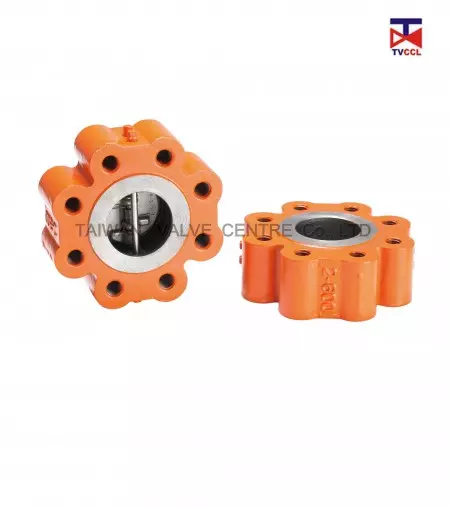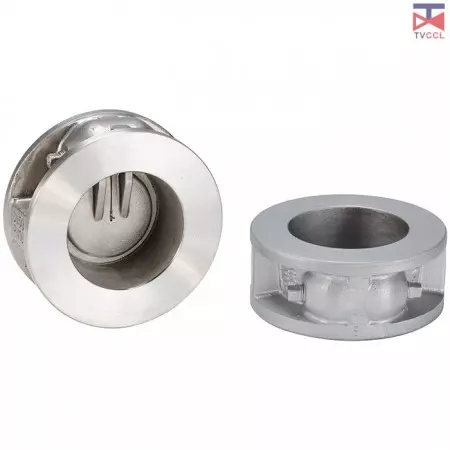Dual plate wafer type check valve for water and waste water treatment
What are the causes of damage to the dual plate wafer type check valve for water and waste water treatment?
Dual plate wafer check valves are commonly used in water treatment plants due to their compact design and efficient operation. However, like all mechanical components in such environments, the valves can be exposed to various challenges that can lead to damage. Here are some of the reasons for damage to the dual plate wafer type check valve in water and wastewater treatment systems
Causes of damage:
- Corrosion: Wastewater often contains a variety of chemicals, salts, and other corrosive agents. Over time, these can corrode the valve, especially if it's not made of corrosion-resistant material.
- Abrasion: Waste water can contain suspended solids and particles. The continuous flow of such water through the valve can cause abrasive wear on the valve plates and sealing surfaces.
- Water hammer: This is a sudden increase in pressure that occurs when a moving fluid is forced to stop or change direction suddenly. Rapid closure of the check valve can cause water hammer, which can damage the valve and other components in the system.
- Cavitation: This phenomenon occurs when the pressure in a liquid drops below its vapour pressure, resulting in the formation of vapour bubbles. When these bubbles collapse, they can cause pitting and erosion on the valve surfaces.
- Foreign objects: Debris or foreign matter in the waste water can become lodged in the dual plate check valve and prevent it from closing properly or cause damage to the valve plates.
- Improper installation: Failure to install the double door check valve correctly can result in misalignment, which can cause uneven wear or even prevent the valve from functioning properly.
- Excessive flow rates: If the flow rate exceeds the dual check valve's design specifications, this can lead to premature wear and possible failure.
- Improper material selection: If the valve material is not suitable for the specific wastewater treatment conditions, such as high chlorine or sulphur levels, it may cause premature failure.
- Lack of maintenance: Regular inspection and maintenance are critical to the longevity of any valve. If maintenance is neglected, problems can go unnoticed until they cause significant damage.
- Temperature Fluctuations: In some wastewater treatment processes, temperature fluctuations can occur, resulting in thermal expansion and contraction, which can cause stress in the valve material, resulting in stress in the valve material and potential damage.
- Biofouling: In wastewater treatment systems, biological growth or biofouling can occur, resulting in the accumulation of biomass on valve surfaces, which can affect valve operation and potentially cause damage.
- Chemical attack: Wastewater treatment often involves the use of various chemicals for treatment processes. If the valve material is not compatible with these chemicals, material degradation may occur.
To prevent damage and ensure the longevity of dual plate wafer check valves in water treatment plants, it's essential to select the right valve for the application, ensure proper installation and carry out regular maintenance and inspections. Addressing problems early can prevent more significant problems and system failures in the future.
Solutions:
● Material selection: Choose corrosion resistant materials such as stainless steel, duplex stainless steel or special alloys suitable for wastewater conditions.
● Regular maintenance: Periodically inspect and clean the valve to remove debris, accumulated solids, and biofouling.
● Install water hammer arrestors: These devices can absorb the shock wave caused by sudden valve closures, reducing the effects of water hammer.
● Correct installation: Ensure the valve is correctly aligned and installed according to the manufacturer's guidelines.
● Flow control: Use flow control devices to ensure that flow rates remain within the valve design specifications.
● Anti-cavitation design: Some valves are designed to minimise cavitation. Consider using these if cavitation is a concern.
● Use strainers: Installing strainers upstream of the valve can help filter out debris and larger particles, preventing them from reaching the valve.
● Temperature control: If temperature fluctuations are an issue, consider using insulation or other temperature control measures.
● Chemical compatibility: Ensure that the valve material is compatible with any chemicals used in the treatment process.
● Periodic inspections: Regular inspections can help identify and correct problems before they cause significant damage.
● Replace worn components: If parts of the valve, such as sealing surfaces, show signs of wear, consider replacing them before they fail.
● Training: Ensure that personnel are trained in the proper operation and maintenance of the valve to prevent misuse.
By proactively addressing these issues and implementing the suggested solutions, the longevity and functionality of dual plate wafer check valves in water and wastewater treatment systems can be ensured.
⊛ Proper Installation: Ensure the valve is correctly aligned and installed as per manufacturer guidelines.
⊛ Flow Control: Use flow control devices to ensure flow rates remain within the valve's design specifications.
⊛ Anti-Cavitation Design: Some valves are designed to minimize cavitation. Consider using these if cavitation is a concern.
⊛ Use Strainers: Installing strainers upstream of the valve can help filter out debris and larger particulates, preventing them from reaching the valve.
⊛ Temperature Control: If temperature fluctuations are a concern, consider using insulation or other temperature control measures.
⊛ Chemical Compatibility: Ensure the valve material is compatible with all chemicals used in the treatment process.
⊛ Regular Inspections: Periodic inspections can help identify and address issues before they lead to significant damage.
⊛ Replace Worn Components: If parts of the valve, like the sealing surfaces, show signs of wear, consider replacing them before they fail.
⊛ Training: Ensure that personnel are trained on the proper operation and maintenance of the valve to prevent mishandling.
By addressing these issues proactively and implementing the suggested solutions, the longevity and functionality of dual plate wafer type check valves in water and wastewater treatment systems can be ensured.
- Related Products
Dual Plate Wafer Type Check Valve
TC0
Fast Delivery: Most orders are shipped within 3-7 days, depending on stock availability. Versatile Applications: Suitable for a wide range of industries...
DetailsDual Plate Wafer Type Check Valve with Full Rubber
TC1
Dual plate wafer type check valve with full rubber is usually used in seawater desalination system. Usually we chose iron body and aluminum bronze disc...
DetailsDual Plate Flange Type Check Valve
TC4
Because the check valve flange type doesn’t tapping on the flange hole, installation of double door flange type check valve is simpler than double door...
DetailsDual Plate Lug Type Check Valve
TC6
Lug type double disc check valves typically feature multiple threaded bolt holes around the valve body, allowing direct flange connection without the need...
DetailsDual Plate Full Lug Type Check Valve
TC9
Double disc lug type check valves are designed to ASME, JIS, ISO, AWWA...etc. specifications and conform to API 594. Double disc lug type check valves...
DetailsSingle Door Wafer Type Check Valve with Short Type
TS-1
TVCCL's single door check valve offers numerous advantages customized for modern industrial requirements. Its compact design facilitates effortless integration...
DetailsSingle Door Wafer Type Check Valve With Long Type
TS-2
Single-plate wafer check valves are also called swing type that performs the same with swing check valve with much less cost. The Long type Single plate...
Details







